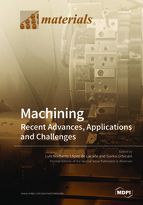Machining—Recent Advances, Applications and Challenges
A special issue of Materials (ISSN 1996-1944).
Deadline for manuscript submissions: closed (31 May 2019) | Viewed by 143081
Special Issue Editors
Interests: manufacturing process
Special Issues, Collections and Topics in MDPI journals
Interests: modeling of metal removal processes; machining dynamics; chatter vibrations
Special Issues, Collections and Topics in MDPI journals
Special Issue Information
Dear Colleagues,
In 1907, the American engineer, F.W. Taylor, exposed the basis and fundamentals of modern machining concepts, such as the relationship between tool life and cutting speed, the economic optimization of the machining processes, and modern management of industrial companies, which along with previous developments of new grades of high-alloyed steels (HSS) for the production of cutting tools, promoted a rapid evolution of machining processes. In the 20th century, continuous advances happened one after the other, related to the invention of sintered carbide tools, coatings, the introduction of CNC in machine-tools, multitasking and multiprocess concepts, etc. At the start of this century, machining remains the key operation to achieve high productivity and precision for high-added value parts in several sectors. Continous research is performed and new ideas are constantly considered.
This Special Issue is open to new advances in machining aspects, involving:
- High performance operations for difficult-to-cut alloys, wrought and cast materials, light alloys, ceramics, etc.
- Cutting tools, grades, substrates and coatings. Wear damage.
- New applications of machining in high-added value components, for aeronautics, automotive, windmill, energy, and other key sectors.
- Heat in metal cutting: Heat sources, accuracy in machining, prediction and measurements of temperatures in the cutting zone.
- New approaches in the tribology of the cutting process.
- Advanced cooling in machining: Minimum quantity of lubricant, dry or cryogenics.
- Modelling, focused on the reduction of risks, the process outcome, and to maintain surface integrity.
- Vibration problems in machines: Active and passive/predictive methods, sources, diagnosis and avoidance.
- Influence of machining in new concepts of machine–tool, and machine static and dynamic behaviors.
- Machinability of new composites, brittle and emerging materials.
- Sensor-assisted machining: Sensors and system architecture, intelligent/smart tools.
- Machining economics and optimization: Advanced methods.
- Assisted machining processes by high-pressure, laser, US and others.
- Micromachining, challenges and applications.
- Introduction of new analytics and decision making into machining programming.
Prof. Dr. Luis Norberto López De Lacalle
Dr. Gorka Urbicain
Guest Editors
Manuscript Submission Information
Manuscripts should be submitted online at www.mdpi.com by registering and logging in to this website. Once you are registered, click here to go to the submission form. Manuscripts can be submitted until the deadline. All submissions that pass pre-check are peer-reviewed. Accepted papers will be published continuously in the journal (as soon as accepted) and will be listed together on the special issue website. Research articles, review articles as well as short communications are invited. For planned papers, a title and short abstract (about 100 words) can be sent to the Editorial Office for announcement on this website.
Submitted manuscripts should not have been published previously, nor be under consideration for publication elsewhere (except conference proceedings papers). All manuscripts are thoroughly refereed through a single-blind peer-review process. A guide for authors and other relevant information for submission of manuscripts is available on the Instructions for Authors page. Materials is an international peer-reviewed open access semimonthly journal published by MDPI.
Please visit the Instructions for Authors page before submitting a manuscript. The Article Processing Charge (APC) for publication in this open access journal is 2600 CHF (Swiss Francs). Submitted papers should be well formatted and use good English. Authors may use MDPI's English editing service prior to publication or during author revisions.
Keywords
- machining
- machine-tools
- cutting tools
- machinability
- modelling
- tribology








